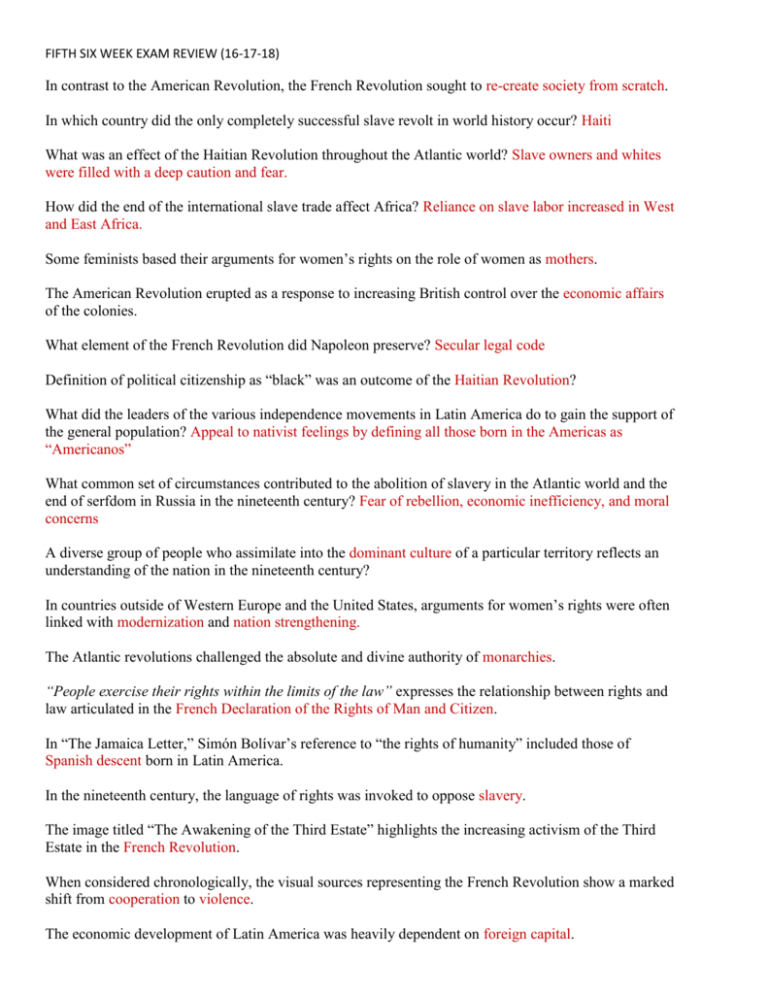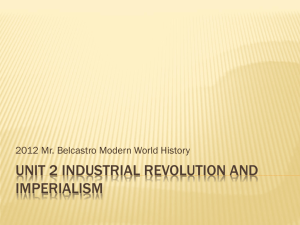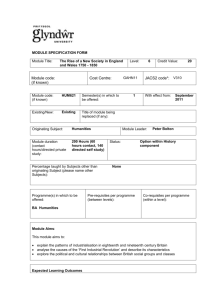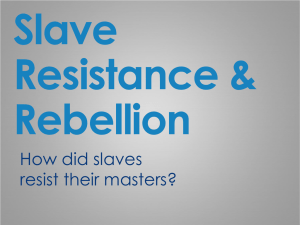FIFTH SIX WEEK EXAM REVIEW (16-17
advertisement

FIFTH SIX WEEK EXAM REVIEW (16-17-18) In contrast to the American Revolution, the French Revolution sought to re-create society from scratch. In which country did the only completely successful slave revolt in world history occur? Haiti What was an effect of the Haitian Revolution throughout the Atlantic world? Slave owners and whites were filled with a deep caution and fear. How did the end of the international slave trade affect Africa? Reliance on slave labor increased in West and East Africa. Some feminists based their arguments for women’s rights on the role of women as mothers. The American Revolution erupted as a response to increasing British control over the economic affairs of the colonies. What element of the French Revolution did Napoleon preserve? Secular legal code Definition of political citizenship as “black” was an outcome of the Haitian Revolution? What did the leaders of the various independence movements in Latin America do to gain the support of the general population? Appeal to nativist feelings by defining all those born in the Americas as “Americanos” What common set of circumstances contributed to the abolition of slavery in the Atlantic world and the end of serfdom in Russia in the nineteenth century? Fear of rebellion, economic inefficiency, and moral concerns A diverse group of people who assimilate into the dominant culture of a particular territory reflects an understanding of the nation in the nineteenth century? In countries outside of Western Europe and the United States, arguments for women’s rights were often linked with modernization and nation strengthening. The Atlantic revolutions challenged the absolute and divine authority of monarchies. “People exercise their rights within the limits of the law” expresses the relationship between rights and law articulated in the French Declaration of the Rights of Man and Citizen. In “The Jamaica Letter,” Simón Bolívar’s reference to “the rights of humanity” included those of Spanish descent born in Latin America. In the nineteenth century, the language of rights was invoked to oppose slavery. The image titled “The Awakening of the Third Estate” highlights the increasing activism of the Third Estate in the French Revolution. When considered chronologically, the visual sources representing the French Revolution show a marked shift from cooperation to violence. The economic development of Latin America was heavily dependent on foreign capital. During Europe’s industrial revolution unique features of European society, economy, or history gave it a long-term advantage and head-start in industrializing. Until about 1750, core areas of Europe, India, and China enjoyed similar levels of economic development which serves to counter the notion that European culture is inherently more suited to industry and technology? The Scientific Revolution in Great Britain fostered technological innovation which has been offered as an explanation for why Britain was the first European country to industrialize. Even regions that failed to industrialize were impacted by industrialization which madethe Industrial Revolution a global phenomenon by the end of the nineteenth century? The state played a greater role in industrial development in Russia than in the United States or Western Europe. Latin America provided the food products, raw materials, and markets for industrializing countries. What group benefited the most from the Industrial Revolution in nineteenth-century Britain? The middle classes Which was the only country in Latin America to experience a nationwide revolution in the early twentieth century? Mexico The decline in peasant farming in their homelands pushed many Europeans to immigrate in the nineteenth century. U.S. intervention in Central America in the early twentieth century was primarily to support American corporate interests in Cuba, Haiti, the Dominican Republic, Nicaragua, and Mexico. In The Communist Manifesto, what special term do Karl Marx and Friedrich Engels use to describe: “These laborers, who must sell themselves piecemeal, are a commodity, like every other article of commerce, and are consequently exposed to all the vicissitudes of competition, to all the fluctuations of the market.”? The proletariat “He’s only a weaver that no one owns.” reflects the perspective of skilled artisans who lost their means of livelihood as a result of the Industrial Revolution Samuel Smiles considered increased education to be the best way to help the English working class? The figures depicted in the engraving of the 1851 Crystal Palace Exhibition suggest that those who benefited from the Industrial Revolution were the wealthy elite. Which detail in the painting of female laborers during dinner hour conveys a positive impression of factory life? The activities in which the women are engaged In the photograph of a factory, what is the male figure smoking a pipe most likely doing? Supervising the workers The superior organization and discipline of European militaries gave Europeans an advantage in their encounters with people in Asia and Africa during the second half of the nineteenth century. One of the effects of colonial rule in Africa was that women of impoverished families became heads of household in the absence of men. How did colonial rule alter ways of working in Africa and Asia in the nineteenth century? More people worked on public projects for free. The notion of an Africa divided into tribes shaped the development of African identity in the nineteenth century. The colonization of New Zealand, Australia, and Hawaii during the nineteenth century was most similar to the colonization of North America in the seventeenth century. In the imperialism of the nineteenth century, how did the number of European settlers in African and Asian colonies generally affect the extent of racial segregation and discrimination? Colonies with a large European settler population experienced more racial discrimination and racial segregation. The spread of Christianity in Africa was facilitated by its association with modern education. How did the spread of Western education affect colonial society? It created a new elite who saw themselves as a modernizing vanguard in the regeneration of their societies. The peaceful negotiations among the competing European states over “who got what” characterized the “scramble for Africa” that led to the partition of nearly all of Africa among European colonial powers. European colonial rule in the nineteenth century generally depended upon and reinforced the power of the most conservative of Asian and African societies. What elements of the modernizing process did colonial rule convey on colonies? Communication and transportation infrastructure Migration of colonial subjects to work sites overseas resulted from the employment of colonial subjects in European-owned plantations, mines, construction projects, and businesses. “...both Hindus and Muslims, are being ruined under the tyranny and oppression of the infidel and the treacherous English.” This reflects the attitude toward Britain expressed in the Azamgarh Proclamation? In his speech to an audience in London, Dadabhai Naoroji requested political representation for Indians in the British government. What does the image of Cecil Rhodes suggest about his goals for Africa? To build a transcontinental railroad from northern Africa to its southern tip.








